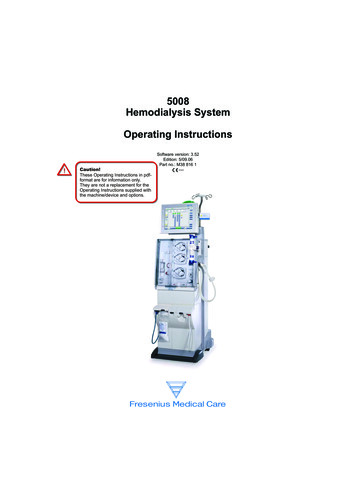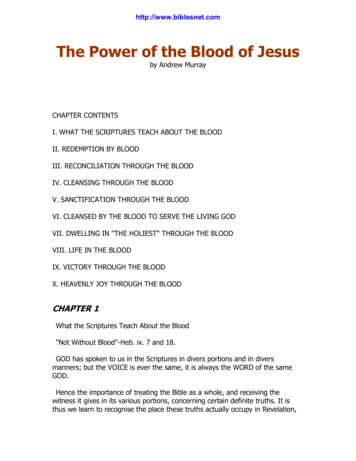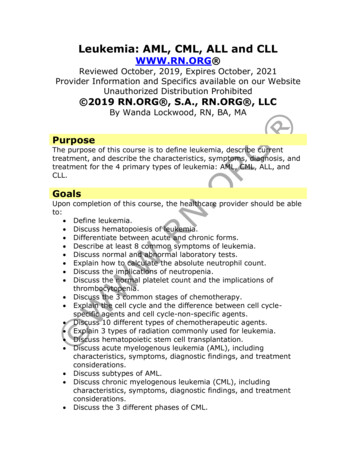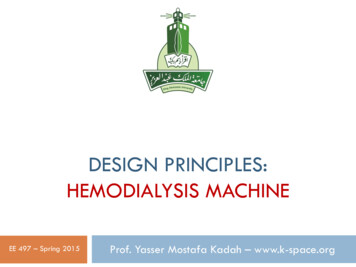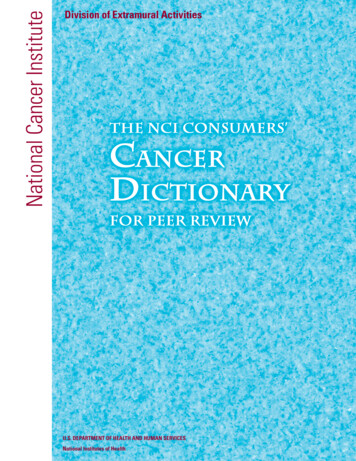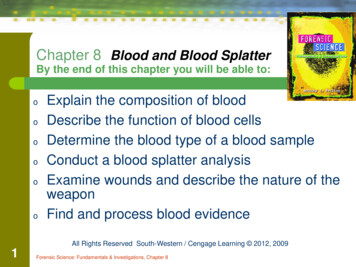
Transcription
Chapter 8 Blood and Blood SplatterBy the end of this chapter you will be able to:ooooooExplain the composition of bloodDescribe the function of blood cellsDetermine the blood type of a blood sampleConduct a blood splatter analysisExamine wounds and describe the nature of theweaponFind and process blood evidenceAll Rights Reserved South-Western / Cengage Learning 2012, 20091Forensic Science: Fundamentals & Investigations, Chapter 8
Introduction and HistoryoBlood typing provides class evidenceoMore than one person has the same blood typeoDNA profiling provides individual evidenceoNeed white blood cellsoA blood splatter pattern provides information 2the truthfulness of an account by a witness or asuspectthe origin of the bloodthe angle and velocity of impactthe type of weapon usedForensic Science: Fundamentals & Investigations, Chapter 8
Composition of Bloodoooo3Plasma—a liquid suspending other bloodcomponentsRed blood cells (Erthrocytes)—carries oxygen tothe body’s cells and carbon dioxide awayWhite blood cells (Leukocytes)—fights diseaseand foreign invaders and, alone, contain cell nucleiPlatelets—aids in blood clotting and the repair ofdamaged blood vesselsForensic Science: Fundamentals & Investigations, Chapter 8
What can an investigator learn from the analysis of ablood spatter?ooooooooType and velocity of weaponNumber of blowsHandedness of assailant (right or left-handed)Position and movements of the victim and assailant duringand after the attackWhich wounds were inflicted firstType of injuriesHow long ago the crime was committedWhether death was immediate or delayed
Composition of Blood5Forensic Science: Fundamentals & Investigations, Chapter 8
Composition of Blood*only write underlined partooooRED BLOOD CELLS (Erythrocytes) –Produced in the bonemarrow, contain a protein called hemoglobin that carries oxygento our cells.WHITE BLOOD CELLS (Leukocytes) –Part of the immunesystem and destroy infectious agents called pathogens.PLASMA –Yellowish liquid portion of blood that containselectrolytes, nutrients and vitamins, hormones, clotting factors,and proteins such as antibodies to fight infection.PLATELETS (Thrombocytes) –They clot together in a processcalled coagulation to seal a wound and prevent a loss of blood.
Types of Blood Cells7Forensic Science: Fundamentals & Investigations, Chapter 8
Interesting Blood FactsThe average adult has about FIVE liters of blood insideof their body, which makes up 7-8% of their bodyweight.Blood is living tissue that carries oxygen and nutrientsto all parts of the body, and carries carbon dioxideand other waste products back to the lungs, kidneysand liver for disposal. It also fights against infectionand helps heal wounds, so we can stay healthy.There are about one billion red blood cells in two tothree drops of blood. For every 600 red blood cells,there are about 40 platelets and one white cell.
Cellular Components of Blood9Forensic Science: Fundamentals & Investigations, Chapter 8
Blood Typing—Proteinsooooo10Discovered in 1900 by Karl LandsteinerIdentifies the presence or absence of particularproteins embedded in the cellQuicker and less expensive than DNA profilingProduces class evidence but can still link asuspect to a crime scene or exclude a suspectBlood did not always freely mix with blood fromanother person.Forensic Science: Fundamentals & Investigations, Chapter 8
Genetics of Blood TypesoBlood type is established before you are BORN,by specific GENES inherited from your parents.oYou inherit one gene from your MOTHER andone from your FATHER.oThese genes determine your blood type by causingproteins called AGGLUTINOGENS to exist onthe surface of all of your red blood cells.
Rh Factor85% of the population has a protein calledRH factor on their blood cells12Forensic Science: Fundamentals & Investigations, Chapter 8
Rh Factors Scientists sometimes study Rhesus monkeysto learn more about the human anatomybecause there are certain similarities betweenthe two species. While studying Rhesusmonkeys, a certain blood protein wasdiscovered. This protein is also present in theblood of some people. Other people, however,do not have the protein. The presence of the protein, or lack of it, isreferred to as the Rh (for Rhesus) factor. If your blood does contain the protein, yourblood is said to be Rh positive (Rh ). If yourblood does not contain the protein, your bloodis said to be Rh negative (Rh-).http://www.fi.edu/biosci/blood/rh.htmlA AB BAB ABO O-
Blood Typing—Antibodiesoo14Antibodies are Y-shapedproteins secreted by whiteblood cells that attach toantigens to destroy themAntigens are foreignmolecules or cells thatreact to antibodiesForensic Science: Fundamentals & Investigations, Chapter 8
Blood Enzymesoo15Enzymes are complex proteins that catalyzedifferent biochemical reactionsMany enzymes and proteins have been found inthe blood that are important for identificationpurposesForensic Science: Fundamentals & Investigations, Chapter 8
Blood Typing—Probability and Blood TypesooThe probability of a blood type equals the product ofprobabilities for each protein groupIf Type A 42% and Rh Factor 85%Then A .42 x .85 .357 (35.7%)Knowing additional proteins and enzymes in theblood sample 16Narrows the population groupIncreases the probability of identifying a suspectForensic Science: Fundamentals & Investigations, Chapter 8
Blood TypingThere are 3 alleles or genes for blood type:A, B, & O.Blood typing is codominantBlood TypesAA or AO Type ABB or BO Type BOO Type OAB Type AB Both dominant alleles show up, ex. d/types.cfm
How common is your blood type?46.1%38.8%11.1%3.9%
Donating BloodWho can give you blood? TYPE O blood is the UniversalDonor, because it can be given toany blood type. TYPE AB blood is the UniversalRecipient, because it can receiveany blood type. Rh Can receive or Rh - Can only receive -Universal DonorUniversal Recipient
Blood Type and Antibodies When a person receives a bloodprotein (AB or RH) that is foreignto him/her, antibodies will causethe blood to clump, may causedeath. Antibodies: help identify foreignbodies; bind to the antigen(foreign body) Antigen-Antibody Response: theattack launched against a foreigninvader (viruses, bacteria,allergens)
Remember Agglutinogens? Review: The genes from parents determine your blood type bycausing proteins called AGGLUTINOGENS to exist on thesurface of all of your red blood cells. Agglutination: clumping of RBCs Can cause clots, ceasing blood flow
Predicting Blood Typeusing Punnett Squares!One parent hereBlood TypesType A Homozygous AA Heterozygous AOType B Homozygous BB Heterozygous BOType O OOType AB ABAAAA AAANow cross!Results:AA 50%AO 50%OOne parent hereA OA O
Practice in your notebook!Blood TypesType A Homozygous AA Heterozygous AOType B Homozygous BB Heterozygous BOType O OOType AB ABA1. AO x ABBAO2. AB x AB3. Homozygous type B withheterozygous type A4. Heterozygous type A withheterozygous type B
Blood Splatteroooo241939—splatter patterns firstanalyzedBlood may splatter when a wound is inflictedBlood splatter pattern—a grouping of bloodstainsPatterns help to reconstruct the eventssurrounding a shooting, stabbing, or beatingForensic Science: Fundamentals & Investigations, Chapter 8
Blood Evidence Blood samples – analyzed to determine blood typeand DNA, which can be matched to possible suspects. Blood droplets – analyzed to give clues to the locationof a crime, movement of a victim, and type ofweapon. Blood spatter – analyzed to determine patterns thatgive investigators clues to how a crime might havehappened.
MicroscopicViewsFish BloodBird BloodHorse BloodFrog BloodCat BloodDog BloodHuman BloodSnake Blood
Examples:*write down bolded part only Phenolphthalein is a chemical that is still utilized today and is usuallyreferred to as the Kastle-Meyer test and produces a pink color when itreacts with hemoglobin. HemaStix is a strip that has been coated with tetramethylbenzidine(TMB) and will produce a green or blue-green color with the presence ofhemoglobin. LuminolThis chemical is used by crime scene investigators to locate traces ofblood, even if it has been cleaned or removed.Investigators spray a luminol solution is throughout the area underinvestigation and look for reactions with the iron present in blood, whichcauses a blue luminescence. FluoresceinThis chemical is also capable of detecting latent or old blood, similar toluminol. It is ideal for fine stains or smears found throughout a crimescene. After the solution has been sprayed onto the substance or areasuspected to contain blood, a UV light and goggles are used to detect anyilluminated areas, which appear greenish-white if blood is present.LuminolReactionFluoresceinReaction inUV Light
How is blood evidence detected at a crime scene? Light Source – high intensity or UV lightFYI: Investigators will first examine the crime scene to lookfor areas that may contain blood. They may use a highintensity light or UV lights to help them find traces of bloodas well as other bodily fluids that are not visible undernormal lighting conditions. Blood Reagent Tests – determine if blood is presentFYI: These tests, referred to as presumptive tests, are usedto detect blood at crime scenes based upon the properties ofhemoglobin in the blood. Further tests at the crime lab candetermine if it is human blood or not.
Kastle-Meyer Presumptive Blood Test Presumptive test: will only reveal the possibility that thesubstance is blood or tell us for certain that the substanceis not blood Based on the reaction of hemoglobin with phenolpthlaleinin the presence of hydrogen peroxide (H202). Hemoglobin is the iron-containing, oxygen-transportprotein in RBCs. Iron in hemoglobin reacts with H202 Breaks it into H20 and a free oxygen radical (0) Free oxygen radical reacts with phenolpthlalein andturns the indicator bright pink/fuschia
Luminol Presumptive Blood Test Hemoglobin reacts with peroxide, forming the free oxygenradical. The free radical is in an excited state and oxidizes luminol,which also enters an excited state. As the luminol falls back to its ground state, light is emitted.
Blood Splatter AnalysisAnalysis of a splatter pattern can aid indetermining the: 31 direction blood traveled and distance traveled angle of impact point of origin of the blood velocity of the blood manner of deathPosition of victim and assailantMovement of victim and assailantForensic Science:Fundamentals &Investigations, Chapter 8
Blood Splatter AnalysisNatural cohesiveness of blood32Forensic Science: Fundamentals & Investigations, Chapter 8
Bloodstain Pattern Analysis Terms Spatter – Bloodstains createdfrom the application of force tothe area where the bloodoriginated. Angle of Impact – The angleat which a blood droplet strikesa surface.
Blood Splatter AnalysisoSatellite droplets— When blood falls from a height, or at a high velocity, It overcomes its natural cohesiveness, and Separates from the main dropletoSpiking patterns— Form around the dropletedges when blood fallsonto a less-than-smoothsurface34Forensic Science: Fundamentals & Investigations, Chapter 8
Dripping Blood Blood trickles downwards Blood drop grows until weight exceeds surface tension(cohesion)Single drop breaks free (teardrop shape) Surface tension pulls it vertically And horizontally Shape settles into sphere Does not break up until impact
Blood Splatter Analysis—DirectionalityThe shape of an individual drop of bloodprovides clues to the direction fromwhere the blood originated.How will the point of impact comparewith the rest of a blood pattern?36Forensic Science: Fundamentals & Investigations, Chapter 8
Examination of Directionality of Blood Circular drop: width and length are equal; fell straight down;90 degree angle Elongated drop: longer than it is wide; indicates directionblood was traveling
Blood Splatter AnalysisLines of convergence—two or blood splatters canpinpoint the location of the blood source38Forensic Science: Fundamentals & Investigations, Chapter 8
Patterns of Blood Spatter1. Passive fall: Blood falling to the floor at a 90-degree anglewill produce circular drops. Satellites will form if thesurface is textured.2. Arterial spurts or gushes: found on walls or ceilings;caused by pumping action of heart3. Splashes: shaped like exclamation points. Shape andposition of the pattern can help locate position of victim atthe time of attack.4. Smears: Left by a bleeding victim as s/he brushes againstan object5. Trails: left by a bleeding victim as s/he moves from oneplace to another6. Pools: victim is bleeding heavily and remains in one place
Blood Splatter Analysis—Six PatternsDescribe each of these:a)b)c)d)e)f)40Passive dropsArterial gushesSplashesSmearsTrailsPoolsForensic Science: Fundamentals & Investigations, Chapter 8
Types of Bloodstain Patterns Passive Bloodstains Projected Bloodstains Transfer or Contact BloodstainsImages from http://www.bloodspatter.com/BPATutorial.htm
Blood Splatter Analysis—Impactoo42Patterns can help investigators determinethe type of weapon usedWhat kind of a pattern is produced by a gunshot?What kind of a pattern is produced by ahammer blow?Forensic Science: Fundamentals & Investigations, Chapter 8
Lab 3: Drop Patterns from an Angled ImpactArc sin of width/length impact angle
Crime Scene Investigationof Blood1. Search for blood evidence2. Determinea. Is the evidence blood?b. Is the blood human?c. What is the blood type?3. Interpret the findings:a. Does the blood type match a suspect’s blood?b. If not, exclude that suspectc. If yes, decide if DNA profiling is necessary44Forensic Science: Fundamentals & Investigations, Chapter 8
Crime-Scene Investigation of BloodSteps taken in processing a blood stain:1. Confirm the stain is blood. Kastle-Meyer Luminol Leukomalachite green (produces a green color in presence of blood)2. Confirm the blood is human.3. Determine blood type.
. . . . . . . . . . . . . . . . . Summaryoooo46Blood consists of cellular components and plasma.The various human blood types are caused by thepresence or absence of A and/or B proteins on thesurface of red blood cells.Blood splatter evidence can be used to recreate acrime scene.Investigators endeavor to (a) locate, (b) identify,and (c) interpret blood splatter patterns at crimescenes.Forensic Science: Fundamentals & Investigations, Chapter 8
3 Forensic Science: Fundamentals & Investigations, Chapter 8 Composition of Blood o Plasma—a liquid suspending other blood components o Red blood cells (Erthrocytes)—carries oxygen to the body's cells and carbon dioxide away o White blood cells (Leukocytes)—fights disease and foreign invaders and, alone, contain cell nuclei o Platelets—aids in blood clotting and the repair of


